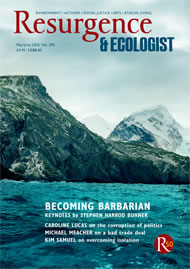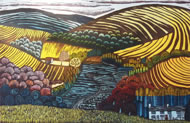Bedwos, crundle, rionnach maoim. Jammed against each other like pieces of rotting crud in landfill, the words may sound like nonsense – a line of Vogon poetry from The Hitchhiker’s Guide to the Galaxy. But come closer, unfold them and listen. Bedwos is a Welsh word for a grove of birch trees. Crundle, in the dialect of Hampshire and Sussex, means a thicket in a hollow through which a stream leads. The Gaelic phrase rionnach maoim refers to the shadows cast on moorland by cumulous clouds moving across the sky on a bright and windy day. Each denotes a capacity for attention, an echo of a life-way, in which, just possibly, ever-living joy and worth beyond price can be found.
That, at least, is the idea behind a project which Robert Macfarlane, one of Britain’s leading Nature writers, envisages in the introduction to Landmarks. “We need now, urgently, a Counter-Desecration Phrasebook that would comprehend the world,” he writes; “a glossary of enchantment for the whole Earth which would allow Nature to talk back and would help us to listen.” And, interspersed through a set of eleven essays about some of the greatest writers in English about Nature and place, that is what he offers in this remarkable new book. In Landmarks, each stratum of a lexico-poetico-meteorologico-aesthetico Berlitz abuts a seam of ecologico-topographico-critico-politico belles-lettres.
As a phrasebook or glossary, Landmarks is a delight and a fascination. Its lumbering size and structure will, however, limit its use in the field. If you want to know the meaning of glaab or wetchered, there is no overall index to show which sub-section of the nine completed sections – on Flatlands, Uplands, Waterlands, Coastlands, Underlands, Northlands, Edgelands, Earthlands and Woodlands – contains it. (Glaab, by the way, is a Shetland word for an opening between hills or between islands through which a distant object may be seen, while wetchered is what they say in Lincolnshire when you are wet through after being caught out in the rain.)
The essays are vintage Macfarlane. They are studies of and reactions to the work of Nan Shepherd, the author of The Living Mountain, about her life in the Cairngorm mountains; Roger Deakin, who swam and wooded through the imaginations of millions of readers; J.A. Baker, obsessive of the peregrine falcon; and Richard Jefferies, Jacquetta Hawkes, John Muir and others less well known, including Peter Davidson and Richard Skelton. Earlier versions of many of these pieces have appeared as introductions to new editions of works by these authors. (The introduction to Landmarks itself is a development of an influential essay first published in 2010.) They will be a great resource for those coming to them for the first time, and for others will richly repay rereading.
Language isn’t thought, but it is a tool for thought, says the anthropologist and linguist Daniel L. Everett. But the power of this tool, for good or ill, should not be underestimated. Language that objectifies has, as Macfarlane writes, largely stunned the Earth out of wonder, facilitating the rendition of all living things and natural systems into a standing reserve ripe for exploitation. But language is also “fundamental to the possibility of re-wonderment, for language does not just register experience, it produces it”.
And while every generation bears the weight of the past, it also creates new spaces of possibility. Preceding an astonishing revelation in the postscript to the book is a marvellous final chapter, drawing on work by Deb Wilenski and her colleagues, about the minds and words of children allowed to run free in a country park in north Cambridgeshire. As Macfarlane describes it, “no map of it could ever be complete, for new stories seethed up from its soil, and its surfaces could give way at any moment. The hollows of its trees were routes to other planets, its subterrane flowed with streams of silver, and its woods were threaded through with filaments of magical force. Within it children could shape-shift into bird, leaf, fish or water.”
Caspar Henderson is the author of The Book of Barely Imagined Beings and is currently writing A New Map of Wonders.








